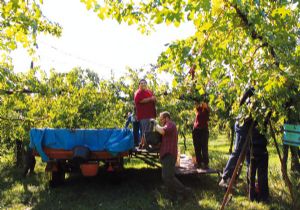An exhibition of contemporary works at Villa Romana, located on the edge of the city, a mile and several centuries from the Pitti Palace, marks the arrival in Tuscany of four new foreign artists.

Villa Romana
Villa Romana—Winners 2013 is a collection assembled by this year’s fellows, each awarded a 10-month residency at the villa. The diversity of the artists precludes a coherent narrative or theme, yet the exhibition is refreshing in its modernity.
Those used to the audio guides or wall scripts of Florence’s state museums may find themselves temporarily lost, as visitors are granted freedom of interpretation. However, as the villa is both home to the exhibition and the artists, who moved from Germany this year, one of the artists might well be on hand to provide a personal account of his or her work.
With its oversized wooden door, tiled floors and ever green garden, Villa Romana is distinctly Florentine. Creativity extends outside, with a pavilion designed by local architects that is used for events in the warmer months.
Inside, the whitewashed walls of the exhibition space are interrupted by a copy of Corriere della Sera: every page of the January 31, 2013 Florence edition is on display. This forms the final stage of Daniel Maier-Reimer’s ‘Florence city border’ piece; a five-day journey along the city’s edge documented in photographs.

Maier-Reimer chose just one image to represent the project—of nondescript vegetation—which in January was displayed on an advertising board before appearing in the newspaper. The artist confessed that he takes value in the journey itself rather than the process of presentation, creating a challenge for the viewer trying to see the story behind a grainy image in newsprint.
More striking are Shannon Bool’s steel sculptures, their size and shape taken from the windows of a women’s prison in Berlin. Attached are prisoners’ belongings, objects of daily life given greater value in bronze. The piece is linked to a video installation, tucked away in what seems to have once been a cupboard. The film, a necessary accompaniment to the sculptures, shows two 10-metre walls designed by Bool and painted with the help of the prisoners over two years. Focus is on the work as art, but the women’s participation and the presence of their belongings has a strong impact.
In the hallway is a wardrobe covered in blankets with appliqué leather circles depicting eyes. Pieced together by Heide Hinrichs, the work is a playful depiction of the body, with hands creeping onto cloth and an additional pair of ‘eyes’ dangling from the rail. She once wrapped a building in blankets, a further bid to explore the relationship between body and architecture.
This theme carries through two of Hinrichs’ additional exhibition pieces: a pattern of fingertips drilled into the wall and a piece of cloth dotted inaccurately to give the impression of brail.
A pile of bricks leaves few clues but for feathers placed between them, a reference by Hinrichs to notes left between stones at sites such as the Jerusalem’s Western Wall. The bricks are made from papier-mâché, a process through which Hinrich consciously washed out the text.

The work that carries the most historical weight—and therefore perhaps the most accessible to a Florentine—comes from Mariechen Danz. Oversized cloth figures are held between glass, a nod to an age when body parts were consigned to jars. The artist has printed anatomy drawings on both figures, taken from sources that include Renaissance studies and the online tool Google Body Labs.
Viewing the art work necessitates a further level of study, as Danz has woven the history of the speech bubble into the work. The two themes blend, with an intestine curling to become a question mark, while hands cast in plastic resin hold the pieces together.
In offering just a handful of works, the exhibition previews what will come over the next 10 months, making Villa Romana a must for those seeking insight into Florence’s contemporary art scene.
The villa has been a home for artists for more than a century, but this year marked the first of a new project for the fellows. The My Villa is Your Villa event held in February was created by the IED Arts Management team as a speed-art-date held at Libreria Brac, which gave Florentines the chance to meet the artists over an aperitivo.
Whether the February event will be repeated is undecided, but once the current exhibition closes it will be worth looking out for the next offering from the new arrivals.
Villa Romana—Winners 2013
via Senese 68
Until March 22, 2013, free entrance
The exhibition is open from Wednesday to Friday, from 2 to 6pm, or by appointment.
Bus 36 and 37 go from Santa Maria Novella to Villa Romana, at via Senese 68 (stop San Gaggio 03). For details, see www.villaromana.org.







